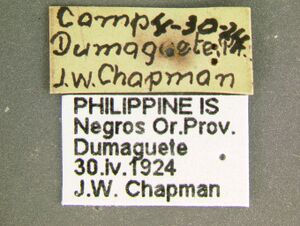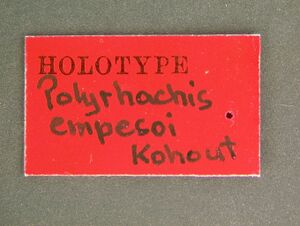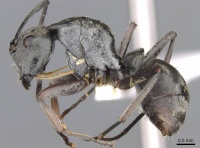Polyrhachis empesoi
| Polyrhachis empesoi | |
|---|---|

| |
| Scientific classification | |
| Kingdom: | Animalia |
| Phylum: | Arthropoda |
| Class: | Insecta |
| Order: | Hymenoptera |
| Family: | Formicidae |
| Subfamily: | Formicinae |
| Tribe: | Camponotini |
| Genus: | Polyrhachis |
| Subgenus: | Myrma |
| Species: | P. empesoi |
| Binomial name | |
| Polyrhachis empesoi Kohout, 2006 | |
Nothing is known about the biology of Polyrhachis empesoi.
Identification
A member of the Polyrhachis parabiotica species group.
Keys including this Species
Distribution
Distribution based on Regional Taxon Lists
Indo-Australian Region: Philippines (type locality).
Distribution based on AntMaps
Distribution based on AntWeb specimens
Check data from AntWeb
Countries Occupied
| Number of countries occupied by this species based on AntWiki Regional Taxon Lists. In general, fewer countries occupied indicates a narrower range, while more countries indicates a more widespread species. |

|
Estimated Abundance
| Relative abundance based on number of AntMaps records per species (this species within the purple bar). Fewer records (to the left) indicates a less abundant/encountered species while more records (to the right) indicates more abundant/encountered species. |

|
Biology
Castes
Worker
    
| |
| . | Owned by Museum of Comparative Zoology. |
Nomenclature
The following information is derived from Barry Bolton's Online Catalogue of the Ants of the World.
- empesoi. Polyrhachis empesoi Kohout, 2006d: 160, figs 3, 6, 9 (w.q.) PHILIPPINES (Negros I.).
Unless otherwise noted the text for the remainder of this section is reported from the publication that includes the original description.
The two available queens are in poor condition. Both are missing numerous legs with one of them also missing the antennae. They were evidently collected separately from the workers, but their morphological characters and general appearance suggest that they are the queens of P. empesoi.
Description
Worker
(holotype cited first): TL c. 6.90, 6.65-7.21; HL 1.75, 1.68-1.75: HW 1.31, 1.28-1.33; CI 75, 74-76; SL 2.18, 2.18-2.28; SI 174, 166-176; PW 1.28, 1.15-1.28; MTL 2.15, 2.06-2.18 (13 measured). Mandibles with 5 teeth reducing in length towards base. Anterior clypeus margin arcuate, distinctly notched medially. Clypeus with blunt, but distinct median carina; clypeus virtually straight in profile, only very shallowly concave behind anterior margin; basal clypeal margin flat, literally represented by thin line. Frontal triangle indistinct. Frontal carinae sinuate with margins raised and moderately laminate at their mid length, rather flat and converging posteriorly. Central area relatively narrow anteriorly, with clearly indicated, short, smooth, median line. Sides of head in front of eyes almost straight, only weakly converging anteriorly towards mandibular bases; rounded behind eyes into highly convex occipital margin. Eyes convex, in full face view only marginally exceeding lateral cephalic outline. Ocelli lacking. Pronotal dorsum weakly convex between pair of relatively long, horizontal, anteriorly directed spines; lateral margins of spines blunt, continuous with rather blunt lateral pronotal margins that terminate just before promesonotal suture. Mesonotal dorsum with blunt lateral margins anteriorly, immarginate posteriorly; metanotal groove distinct. Propodeum immarginate laterally and posteriorly, without propodeal teeth or tubercles. Petiole scale-like, anterior and posterior faces almost flat, converging dorsally and forming acute, medially jagged dorsal margin. Subpetiolar process in profile rounded anteriorly and posteriorly. Anterior face of first gastral segment about as high as petiole, very weakly concave at base, with anterodorsal face narrowly rounding onto dorsum of segment.
Mandibles finely, longitudinally striate with numerous piliferous pits. All body surfaces finely, more-or-less uniformly reticulate-punctate with sculpturation only marginally more distinct laterally.
Mandibles with a few short, semierect, yellowish-golden hairs near masticatory borders and very short, closely appressed hairs towards bases. Anterior clypeal margin usually with three longer, anteriorly directed, medial setae and a few very short setae laterally towards mandibular bases. Clypeus with a few pairs of medium length, erect hairs near anterior and basal margins; distinctly shorter, anteriorly bent hairs along frontal carinae. Anterior face of fore coxae with several, long erect hairs; very short, solitary hairs on ventral surfaces of trochanters of mid and hind legs. Numerous, semi erect, somewhat posteriorly directed, medium length hairs lining posterior margins of apical gastral segments, distinctly longer hairs along sternites and around gastral apex. Short, closely appressed, silvery pubescence abundant on all body surfaces; somewhat longer on meso- and metapleurae, almost completely hiding underlying sculpturation.
Body black, with mandibular masticatory borders, antennae, legs, including coxae, petiole and gaster, medium to dark reddish-brown.
Queen
TL c. 8.42-8.57; HL 2.06-2.09; HW 1.53; CI 72-73; SL 2.57; SI 168; PW 1.72; MTL (missing) (2 measured). Queen essentially as worker with usual differences indicating caste, including three ocelli and complete thoracic structure. Anterior clypeal margin distinctly notched medially; clypeus in profile very weakly sinuate, shallowly concave anteriorly, weakly convex posteriorly, before descending into shallowly impressed basal margin. Eyes somewhat larger and more convex than in worker, clearly exceeding lateral cephalic outline. Pronotal humeri with spines marginally shorter than in worker: mesoscutum wider than long, with lateral margins converging into anteriorly rounded margin: median line clearly indicated: parapsides rather flat, weakly raised posteriorly; mesoscutum in profile rounding anteriorly onto flat dorsum; mesoscutellum only weakly convex, marginally elevated above dorsal plane of mesosoma; metanotal groove strongly impressed. Propodeum immarginate laterally; posteriorly rounding into weakly concave declivity. Petiole, subpetiolar process and anterior face of first gastral segment virtually identical to those in worker. Mandibles finely longitudinally striate. All dorsal surfaces with sculpturation and pilosity similar to that in worker. Body with relatively abundant appressed pubescence more yellowish-golden on head and pronotum, pale yellow on dorsum of gaster and silvery on lateral mesosoma and appendages. Head, mesosoma, petiole and gaster black, with mandibular masticatory borders and appendages dark reddish-brown.
Type Material
Holotype worker, Phillipines: Oriental Negros Prov., Dumaguete, 30.iv.1924, J. W. Chapman. Paratypes: 12 workers, data as for holotype. Holotype and 4 paratypes in Museum of Comparative Zoology; 2 paratypes each in Australian National Insect Collection, The Natural History Museum and Queensland Museum.
Etymology
Named in honour of Domingo Empeso of Silliman University, Dumaguete, Philippines, who collected many Polyrhachis species together with J.W. Chapman on Oriental Negros and elsewhere in the Philippines.
References
References based on Global Ant Biodiversity Informatics
- Kohout R.J. 2006. New species of the Polyrhachis (Myrma) parabiotica species group from the Philippines. Australian Entomologist 33: 155-163.

